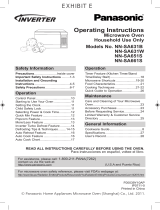
8
IMPORTANT SAFETY INSTRUCTIONS (continued)
10. DO NOT allow children to use this appliance, unless closely supervised by an adult. DO NOT assume that because a child has mastered one cooking
skill he/she can cook everything.
11. DO NOT operate this appliance if it has a damaged cord or plug, if it is not working properly, or if it has been damaged or dropped.
12. DO NOT immerse cord or plug in water.
13. Keep cord away from heated surfaces.
14. DO NOT let cord hang over edge of a table or counter.
15. This appliance should be serviced only by qualified service personnel. Contact the nearest authorized service center for examination, repair or
adjustment.
16. Some products such as whole eggs, with or without shell, narrow neck bottles and sealed containers (for example, closed glass jars) may explode
and should not be heated in this oven.
17. To reduce the risk of fire in the oven cavity:
(a) DO NOT overcook food. Carefully attend appliance when paper, plastic, or other combustible materials are placed inside the oven to facilitate
cooking.
(b) Remove wire twist-ties from paper or plastic bags before placing bag in oven.
(c) If material inside the oven ignites, keep oven door closed, turn oven off, and disconnect the power cord, or shut off power at the fuse or
circuit breaker panel.
(d) DO NOT use the cavity for storage purposes. DO NOT leave paper products, cooking utensils or food in the cavity when not in use.
18. Superheated Liquids: Liquids, such as water, coffee or tea are able to be overheated beyond the boiling point without showing evidence (or signs)
of boiling. Visible bubbling is not always present when the container is removed from the microwave oven. THIS COULD RESULT IN VERY HOT
LIQUIDS SUDDENLY BOILING OVER WHEN THE CONTAINER IS DISTURBED OR A UTENSIL IS INSERTED INTO THE LIQUID. To reduce the risk of injury
to persons:
(a) STIR THE LIQUID BOTH BEFORE AND HALFWAY THROUGH HEATING.
(b) DO NOT heat water and oil, or fats together. The film of oil will trap steam, and may cause a violent eruption.
(c) DO NOT use straight-sided containers with narrow necks.
(d) After heating, allow the container to stand in the microwave oven for a short time before removing the container.
19. DO NOT cook directly on the turntable. It can crack, and cause injury or damage to the oven.
20. This appliance is suitable for use above both gas and electric cooking equipment 91.4 cm (36 inches) or less wide. To reduce the risk of fire and
electric shock, install at least 34.6 cm (1 35/8 inches), above a cooktop, measured to the bottom of the oven.
21. Clean Ventilating hoods Frequently - Grease should not be allowed to accumulate on hood or filter.
22. Use care when cleaning the Grease filter. Corrosive cleaning agents, such as lye-based oven cleaners, may damage the filter. Clean in hot detergent
solution every month.
23. Never flame foods under the oven, with the vent fan operating, because it may spread the flames.
SAVE THESE INSTRUCTIONS
W
TO AVOID THE RISK OF SHOCK:
DO NOT remove outer panel from
oven. Repairs must be done only
by a qualified service person.
TO AVOID THE RISK OF FIRE:
1. DO NOT operate the microwave
oven empty or use metal
containers. When using the
microwave oven without water or
food, microwave energy cannot be
absorbed and will continuously
reflect throughout the cavity. This will cause arcing and damage the
oven cavity, door or other components, which can lead to a fire
hazard.
2. DO NOT store flammable materials next to, on top of, or in the
oven.
TO REDUCE THE RISK OF EXPOSURE TO MICROWAVE ENERGY:
DO NOT tamper with, or make any adjustments or repairs to Door, Control
Panel Frame, Safety Interlock Switches, or any other part of the oven.
Microwave leakage may result.
3. DO NOT dry clothes, newspapers or other
materials in the oven, or use newspaper or paper
bags for cooking.
4. DO NOT hit or strike Control Panel. Damage to
controls may occur.
5. DO NOT use recycled paper products unless the
paper product is labeled as safe for microwave
oven use. Recycled paper products may contain
1. DO NOT operate the oven without the Roller Ring and the Glass
Tray in place.
2. DO NOT operate the oven without the Glass Tray fully engaged
on the drive hub. Improper cooking or damage to the oven could
result. Verify that the Glass Tray is properly engaged and
rotating by observing its rotation when you press Start.




















